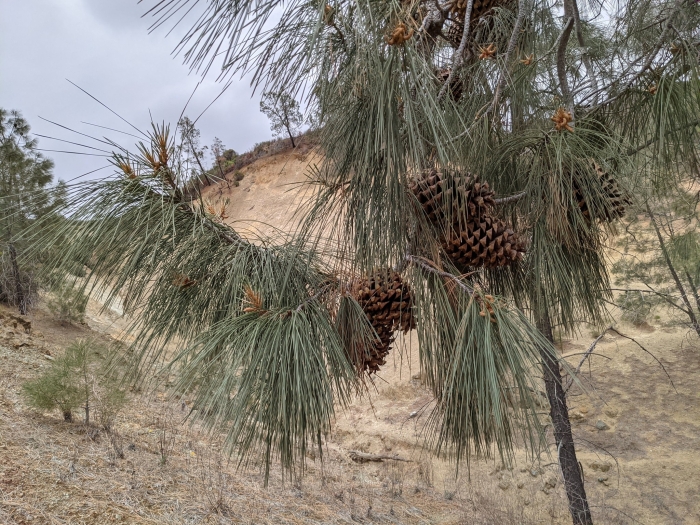California Foothill Pine
(Pinus sabiniana)
California Foothill Pine (Pinus sabiniana)
/
/

Chloe and Trevor Van Loon
CC BY 4.0
Image By:
Chloe and Trevor Van Loon
Recorded By:
Copyright:
CC BY 4.0
Copyright Notice:
Photo by: Chloe and Trevor Van Loon | License Type: CC BY 4.0 | License URL: http://creativecommons.org/licenses/by/4.0/ | Rights Holder: Chloe and Trevor Van Loon | Publisher: iNaturalist | Date Created: 2021-04-25T14:20:24-07:00 |






































































Estimated Native Range
Summary
Pinus sabiniana, commonly known as California Foothill Pine or Gray Pine, is an evergreen tree native to the oak woodlands and chaparral of California’s interior valleys and foothills. It is adapted to a Mediterranean climate with long, hot, dry summers and can be found in areas with a wide range of precipitation, from 15 to 70 inches annually. This species typically grows to 36–45 feet (11–14 m) in cultivation but can reach up to 105 feet (32 m) in its natural habitat. The California Foothill Pine has a distinctive appearance with its pale gray-green needles in fascicles of three, which are sparse and drooping, giving the tree a somewhat wispy look. The seed cones are notably large and heavy, measuring 12–35 cm in length and nearly as wide, which can pose a hazard when they fall. The bark is deeply furrowed and dark gray, providing textural interest.
The California Foothill Pine is valued for its drought tolerance and ability to thrive in a variety of soil types, including rocky, well-drained soils, serpentine soils, and heavy, poorly drained clay soils. It is often used in naturalistic plantings and as a specimen tree in large landscapes due to its unique form and the striking contrast of its foliage against the typically dry landscapes. In cultivation, it requires full sun, minimal water once established, and well-draining soil. While it is not commonly used in urban settings due to its large size and heavy cones, it is an important component of native plant gardens and restoration projects.CC BY-SA 4.0
The California Foothill Pine is valued for its drought tolerance and ability to thrive in a variety of soil types, including rocky, well-drained soils, serpentine soils, and heavy, poorly drained clay soils. It is often used in naturalistic plantings and as a specimen tree in large landscapes due to its unique form and the striking contrast of its foliage against the typically dry landscapes. In cultivation, it requires full sun, minimal water once established, and well-draining soil. While it is not commonly used in urban settings due to its large size and heavy cones, it is an important component of native plant gardens and restoration projects.CC BY-SA 4.0
Plant Description
- Plant Type: Tree
- Height: 60-90 feet
- Width: 25-45 feet
- Growth Rate: Slow
- Flower Color: N/A
- Flowering Season: Non-Flowering
- Leaf Retention: Evergreen
Growth Requirements
- Sun: Full Sun
- Water: Low
- Drainage: Medium, Fast
Common Uses
Bird Garden, Butterfly Garden, Deer Resistant, Drought Tolerant, Edible*Disclaimer: Easyscape's listed plant edibility is for informational use. Always verify the safety and proper identification of any plant before consumption., Fragrant, Low Maintenance, Rabbit Resistant
Natural Habitat
Oak woodlands and chaparral of California’s interior valleys and foothills, adapted to a Mediterranean climate
Other Names
Common Names: Gray Pine, Towani Pine, Digger Pine
Scientific Names: , Pinus sabiniana, Pinus sabineana, Pinus sabineana subsp. error,
GBIF Accepted Name: Pinus sabiniana Douglas ex D.Don